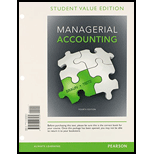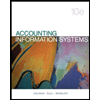
Managerial Accounting, Student Value Edition Plus NEW MyLab Accounting with Pearson eText -- Access Card Package (4th Edition)
4th Edition
ISBN: 9780133849332
Author: Karen W. Braun, Wendy M. Tietz
Publisher: PEARSON
expand_more
expand_more
format_list_bulleted
Textbook Question
Chapter 4, Problem 4.51ACT
Value-Added versus Non-Value-Added at a Restaurant
Go to a fast-food restaurant (or think of the last time you were at a fast-food restaurant). Observe the steps involved in providing a meal to a customer. You will be watching for value-added steps and non-value-added steps. Answer the following questions.
Basic Discussion Questions
- 1. Describe the steps involved with delivering the meal to the customer that you can observe.
- 2. Describe the “behind-the-scenes” processes that are likely in the restaurant, such as cleaning, stocking, and cooking activities.
- 3. With your answers for Questions 1 and 2, list all of the possible activities, materials, and information that you think might be included on a value stream map for the restaurant. Include all of the steps you can think of (not necessarily only those you can observe).
- 4. Make a list of the eight wastes as denoted by the acronym DOWNTIME (Defects, Overproduction, Waiting, Not utilizing people to their full potential, Transportation, Inventory, Movement, and Excess processing). Next to each waste category, list at least one possible non-value-added activity that might or might not be in the processes in that restaurant.
- 5. Go back to the list of items for the potential value stream map. Circle potential areas for improvement and explain which wastes might be involved in those areas.
Expert Solution & Answer
Want to see the full answer?
Check out a sample textbook solution
Students have asked these similar questions
None
Please give me true answer this financial accounting question
What is the project average accounting return?
Chapter 4 Solutions
Managerial Accounting, Student Value Edition Plus NEW MyLab Accounting with Pearson eText -- Access Card Package (4th Edition)
Ch. 4 - Prob. 1QCCh. 4 - Prob. 2QCCh. 4 - Prob. 3QCCh. 4 - Prob. 4QCCh. 4 - Prob. 5QCCh. 4 - Prob. 6QCCh. 4 - Prob. 7QCCh. 4 - Prob. 8QCCh. 4 - Prob. 9QCCh. 4 - Prob. 10QC
Ch. 4 - Prob. 4.1SECh. 4 - S4-2 Use departmental overhead rates to allocate...Ch. 4 - S4-3 Compute departmental overhead rates (Learning...Ch. 4 - S4-4 Compute activity cost allocation rates...Ch. 4 - Prob. 4.5SECh. 4 - Prob. 4.6SECh. 4 - Prob. 4.7SECh. 4 - Prob. 4.8SECh. 4 - Prob. 4.9SECh. 4 - Prob. 4.10SECh. 4 - Prob. 4.11SECh. 4 - S4-15 Identifying waste activities in an office...Ch. 4 - Prob. 4.12SECh. 4 - Prob. 4.13SECh. 4 - Prob. 4.14SECh. 4 - Prob. 4.16SECh. 4 - Prob. 4.17AECh. 4 - Prob. 4.18AECh. 4 - Prob. 4.19AECh. 4 - Prob. 4.20AECh. 4 - Prob. 4.21AECh. 4 - Prob. 4.22AECh. 4 - Prob. 4.23AECh. 4 - Prob. 4.24AECh. 4 - Prob. 4.25AECh. 4 - Prob. 4.27AECh. 4 - Prob. 4.26AECh. 4 - Prob. 4.28BECh. 4 - Prob. 4.29BECh. 4 - Prob. 4.30BECh. 4 - Prob. 4.31BECh. 4 - Prob. 4.32BECh. 4 - Prob. 4.33BECh. 4 - Prob. 4.34BECh. 4 - Prob. 4.35BECh. 4 - Prob. 4.36BECh. 4 - Prob. 4.38BECh. 4 - Prob. 4.39APCh. 4 - Prob. 4.40APCh. 4 - Prob. 4.41APCh. 4 - P4-42A Using ABC in conjunction with quality...Ch. 4 - Prob. 4.43APCh. 4 - Prob. 4.44BPCh. 4 - Prob. 4.45BPCh. 4 - Prob. 4.46BPCh. 4 - Prob. 4.47BPCh. 4 - Prob. 4.48BPCh. 4 - Discussion Questions 1. Explain why departmental...Ch. 4 - ABC in Real Companies Choose a company in any of...Ch. 4 - Value-Added versus Non-Value-Added at a Restaurant...Ch. 4 - Ethics involved with ABC and hazardous waste costs...
Knowledge Booster
Learn more about
Need a deep-dive on the concept behind this application? Look no further. Learn more about this topic, accounting and related others by exploring similar questions and additional content below.Similar questions
- Tundra Tack manufactures horse saddles. In 2015, fixed overhead was applied to products at the rate of $9 per unit. Variable cost per unit remained constant throughout the year. In September 2015, income under variable costing was $195,000. September's beginning and ending inventories were 18,500 and 9,700 units, respectively. a. Calculate income under absorption costing assuming no variances. b. Assume instead that the company's September beginning and ending inventories were 10,200 and 13,800 units, respectively. Calculate income under absorption costing.arrow_forwardWhat is devaneys projected 2019 net income?arrow_forwardGive true answer this financial accounting questionarrow_forward
arrow_back_ios
SEE MORE QUESTIONS
arrow_forward_ios
Recommended textbooks for you
- Century 21 Accounting Multicolumn JournalAccountingISBN:9781337679503Author:GilbertsonPublisher:Cengage
 Pkg Acc Infor Systems MS VISIO CDFinanceISBN:9781133935940Author:Ulric J. GelinasPublisher:CENGAGE L
Pkg Acc Infor Systems MS VISIO CDFinanceISBN:9781133935940Author:Ulric J. GelinasPublisher:CENGAGE L - Principles of Accounting Volume 2AccountingISBN:9781947172609Author:OpenStaxPublisher:OpenStax College
 College Accounting (Book Only): A Career ApproachAccountingISBN:9781337280570Author:Scott, Cathy J.Publisher:South-Western College Pub
College Accounting (Book Only): A Career ApproachAccountingISBN:9781337280570Author:Scott, Cathy J.Publisher:South-Western College Pub

Century 21 Accounting Multicolumn Journal
Accounting
ISBN:9781337679503
Author:Gilbertson
Publisher:Cengage


Pkg Acc Infor Systems MS VISIO CD
Finance
ISBN:9781133935940
Author:Ulric J. Gelinas
Publisher:CENGAGE L


Principles of Accounting Volume 2
Accounting
ISBN:9781947172609
Author:OpenStax
Publisher:OpenStax College

College Accounting (Book Only): A Career Approach
Accounting
ISBN:9781337280570
Author:Scott, Cathy J.
Publisher:South-Western College Pub
What is Business Analysis?; Author: WolvesAndFinance;https://www.youtube.com/watch?v=gG2WpW3sr6k;License: Standard Youtube License